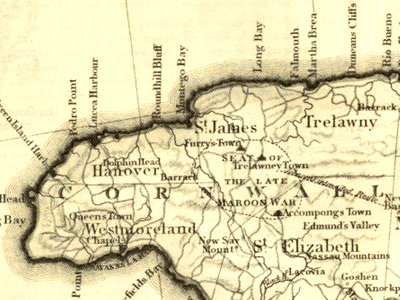The Second Maroon War started in July 1795 among the Trelawny
Town Maroons (the neighbouring Maroons at Accompong refused to join
them and later helped to fight against them). The primary cause of
the trouble was said to be the flogging of two Trelawny Town
Maroons for stealing pigs: though the flogging itself was not
objected to, it was the fact that a Negro work house driver had
wielded the whip and that many of the other prisoners who had been
allowed to look on and mock were runaway slaves who had been caught
by the Maroons and handed over to the authorities for punishment
(see Black: The Story of Jamaica). The trouble seems to have
needlessly escalated because the newly-arrived Governor Balcarres
believed in strong measures, and also because of fears that French
agents were involved (NB the revolution in nearby St Domingue,
which was to result in the creation of the Republic of Haiti, was
in full swing).  The Maroons, numbering maybe 500, were able to hold
out for five months against the might of the British Empire. The
Maroons escalated the war by raiding outlying plantations, killing
the planters and their families and releasing the slaves (Catadupa,
Lapland and Mocha were among the estates which were burned). At
this time General Walpole was placed in command and one of his
actions was to build a chain of armed posts around the Cockpit
Country so that the Maroons could be attacked without the long,
tiring marches. The Government also decided to bring in 100
bloodhounds and 40 handlers (chasseurs) from Cuba. This
finally forced the Maroons into negotiations. It seems that the
Maroons should have surrendered within three days of January 1,
but, for various reasons, it actually took until mid-March for all
to come in. The Assembly and Council seems to have used this as a
pretext to deport all the Trelawny Town Maroons, not just the
latecomers. Despite Gen. Walpole's protests, they were shipped to
the cold of Nova Scotia. They did not do well here and, in 1800,
were transported to Sierra Leone.
The Maroons, numbering maybe 500, were able to hold
out for five months against the might of the British Empire. The
Maroons escalated the war by raiding outlying plantations, killing
the planters and their families and releasing the slaves (Catadupa,
Lapland and Mocha were among the estates which were burned). At
this time General Walpole was placed in command and one of his
actions was to build a chain of armed posts around the Cockpit
Country so that the Maroons could be attacked without the long,
tiring marches. The Government also decided to bring in 100
bloodhounds and 40 handlers (chasseurs) from Cuba. This
finally forced the Maroons into negotiations. It seems that the
Maroons should have surrendered within three days of January 1,
but, for various reasons, it actually took until mid-March for all
to come in. The Assembly and Council seems to have used this as a
pretext to deport all the Trelawny Town Maroons, not just the
latecomers. Despite Gen. Walpole's protests, they were shipped to
the cold of Nova Scotia. They did not do well here and, in 1800,
were transported to Sierra Leone.
Barracks were built in the upper part of Trelawny Town, known by the Maroons as Kojo (Cudjoe) Town, and the area was renamed Flagstaff. The lower part of the Town was originally called "Furry's Town" after Furry, who seems to have been the last of the Maroon chiefs to retain the original prestige of the office. Furry moved downhill after a dispute with the rest of the Trelawny Town Maroons over the succession. This is the present-day Maroon Town, which, of course, is notable for not having any Maroons left! We value your feedback and comments: